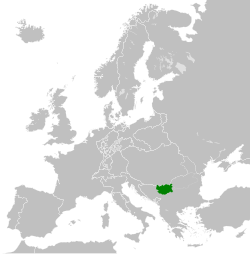
Back বিপ্লবী সার্বিয়া Bengali/Bangla Revoluční Srbsko Czech Επαναστατημένη Σερβία Greek Serbia revolucionaria Spanish Serbia Revolusioner ID Karađorđeva Srbija Serbo-Croatian Serbia Revolucionare Albanian Карађорђева Србија Serbian รัฐปฏิวัติเซอร์เบีย Thai
Revolutionary Serbia Устаничка Србија Ustanička Srbija | |||||||||||
|---|---|---|---|---|---|---|---|---|---|---|---|
| 1804–1813 | |||||||||||
 Revolutionary Serbia within Europe, 1812 | |||||||||||
| Status | Self-proclaimed rebel sovereign state | ||||||||||
| Capital | |||||||||||
| Official languages | Serbian | ||||||||||
| Religion | Serbian Orthodoxy (official) | ||||||||||
| Demonym(s) | Serbian, Serb | ||||||||||
| Government | Not specified1 | ||||||||||
| Grand Vožd | |||||||||||
• 1804–1813 | Karađorđe | ||||||||||
| President of the Governing Council | |||||||||||
• 1805–1807 | Matija Nenadović | ||||||||||
• 1811–1813 | Karađorđe | ||||||||||
| History | |||||||||||
• Established | 1804 | ||||||||||
| 1804–1813 | |||||||||||
| July 1806–January 1807 | |||||||||||
| 10 July 1807 | |||||||||||
• Restoration of Ottoman rule | October 1813 | ||||||||||
• Disestablished | 1813 | ||||||||||
| Area | |||||||||||
| 1815[1] | 24,440 km2 (9,440 sq mi) | ||||||||||
| Population | |||||||||||
• 1815[1] | 332,000 | ||||||||||
| ISO 3166 code | RS | ||||||||||
| |||||||||||
^1 Possibly a hereditary monarchy, at least from 1811, when the People's Governing Council, soon after its establishment, recognized Karađorđe as Serbia's hereditary leader and pledged allegiance to his "lawful heirs".[2] | |||||||||||
Revolutionary Serbia (Serbian: Устаничка Србија / Ustanička Srbija), or Karađorđe's Serbia (Serbian: Карађорђева Србија / Karađorđeva Srbija), refers to the state established by the Serbian revolutionaries in Ottoman Serbia (Sanjak of Smederevo) after the start of the First Serbian Uprising against the Ottoman Empire in 1804. The Sublime Porte first officially recognized the state as autonomous in January 1807, however, the Serbian revolutionaries rejected the treaty and continued fighting the Ottomans until 1813. Although the first uprising was crushed, it was followed by the Second Serbian Uprising in 1815, which resulted in the creation of the Principality of Serbia, as it gained semi-independence from the Ottoman Empire in 1817.
- ^ Michael R. Palairet (2002). The Balkan Economies c. 1800-1914: Evolution Without Development. Cambridge University Press. pp. 16–. ISBN 978-0-521-52256-4.
- ^ Singleton 1985, p. 80.
© MMXXIII Rich X Search. We shall prevail. All rights reserved. Rich X Search

